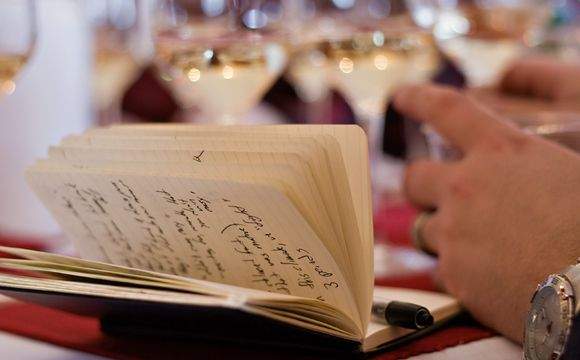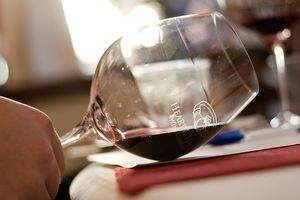
By Evan Dawson, Finger Lakes Editor
Photos from our WoTY 2009 Tasting by Morgan Dawson
I’m happy to see that the NYCR selections for Finger Lakes red wines of the year have generated a fair amount of feedback and debate. There have been many questions: Why no cabernet franc? How come every wine is made from a different grape?
 Keep in mind that for a wine to be eligible, it has to have been released in 2011. Many of the red wines released in 2011 came from the uneven 2009 vintage. The glorious 2009 September produced strong conditions for Finger Lakes pinot noir, but otherwise, it was a down vintage for reds. Some of the wines released in 2011 were from 2008, a solid-if-not-spectacular vintage. Very few of the 2010s have been released yet. If the vintage conditions and barrel tastings are any indication, they will be very good.
Keep in mind that for a wine to be eligible, it has to have been released in 2011. Many of the red wines released in 2011 came from the uneven 2009 vintage. The glorious 2009 September produced strong conditions for Finger Lakes pinot noir, but otherwise, it was a down vintage for reds. Some of the wines released in 2011 were from 2008, a solid-if-not-spectacular vintage. Very few of the 2010s have been released yet. If the vintage conditions and barrel tastings are any indication, they will be very good.
Cabernet franc fans, no worries: I expect that variety will be back in force in future years. But this lineup makes a statement, which is this:
Continued exploration and experimentation with red grape varieties in the Finger Lakes should be welcomed and celebrated.
Unlike riesling, the clear viticultural star of the region, there is no clear dominant red variety. That does not mean that red varieties can’t thrive. In fact, it means that with some hard work and inquiry, a range of red varieties can make impressive wines. Each wine on the list comes with further confirmation of this idea.
Red Tail Ridge Winery 2009 Teroldego
I confess that, having tasted the bottled 2009 and the still-in-barrel 2010, I am even more excited about the newer vintage. But that should not prevent anyone from checking out this wine.
Winemaker Nancy Irelan has a long background in research, and without divulging the secrets she’s trying to keep under wraps in her lab, it’s fair to say that she has even more ideas for cool-climate red grapes. Teroldgeo was one of her first experiments. It is paying off.
The first vintage of teroldego came in 2008, and Irelan took the grapes from those young vines and turned them into an unusual red sparkler. That rapidly gained a following, but I’m glad that Irelan has not diverted from her plan of making a still teroldego. The grape provides nice acidity but also a backbone of chewy tannins. The flavors are unusual, and it’s already showing signs of complexity.
Teroldego is grown primarily in northeastern Italy. Want to get really geeky? It’s also grown in parts of California, where it’s occasionally compared to zinfandel. That’s probably because there is an inherent spice to the grape, which is related to the dureza grape, the father of syrah.
See, don’t you want to see what else Irelan will try?
Rooster Hill Vineyards 2008 Reserve Lemberger
This grape variety continues its slow but steady accumulation of fans in the Finger Lakes. You say lemberger, I say blaufrankisch, but whatever: Rooster Hill has turned out a very nice version.
Some winemakers are choosing to blend lemberger with cabernet franc, aiming for a complex blend of flavors and aromatics. I understand that, but I also enjoy seeing what blaufrankisch can do as a varietal.
In normal-to-ripe vintages, lemberger can produce structured reds with spicy and dark flavors. (Hosmer winemaker Aaron Roisen sees lemberger’s future as more akin to the softer pinot noirs of the world, but he’s the regional exception.)
The first time I tasted this wine with Rooster HIll owner Amy Hoffman, she was obviously excited about it. And yet she patiently waited to bring it to market, confident that the wine’s makeup will allow a long life. I think she made the right call. Is there too much oak? For me, no. But watch for the oak influence in other lembergers or blaufrankisches, which can be sensitive to wood.
McGregor Vineyard 2007 Black Russian Red 30-Month Barrel Reserve
Saperavi and Sereksiya Charni. Those two grapes alone make this wine interesting.
Here’s a wine with a celebrated history, an intensely devoted following, and yet owner John McGregor decided to do something he’d never done before: He held half the vintage back, keeping it in barrel for a full year longer than most vintages.
What’s the result? Thanks to a powerhouse vintage, the wine stands up very well. I go back and forth on the need to decant wines - and for how long - but certainly I would not hesitate to give this wine some air before drinking it.
It’s unique, and it has the structure to age with grace. The McGregor family proves it with annual verticals and library tastings. This is one of the most expensive wines in the Finger Lakes, and yet it has no trouble selling.
Billsboro Winery 2010 Syrah
Syrah is occasionally misunderstood as a warm-climate variety. Its history shows a grape highly adaptable to its climate; it can produce some big, powerful wines in California, and its sweet spot in Cote-Rotie is much cooler. Neither of those regions is as cool as the Finger Lakes, but a group of winemakers is giving this variety an extended shot to succeed.
No one knew the success would come so soon. Damiani is understandably proud of their version, as are a handful of others, including Lucas and Red Newt Cellars. But the Billsboro version is the most intriguing yet.
We should have seen it coming. Syrah needs time to ripen, and 2009 simply didn’t provide the growing season that a winemaker wants. And yet Vinny Aliperti’s ’09 Syrah was relatively prodigious. He couldn’t explain it, other than to credit the Seneca Lake growers: Sawmill Creek Vineyards, where Billsboro sources its fruit.
So if he could produce that kind of syrah in 2009, it’s not a surprise that 2010 finds a truly broad-shouldered, layered version that could attract the admiration of syrah lovers. Our own Mark Grimaldi was floored by this wine. And if you know Mark, you know that he has very tough standards.
Ravines Wine Cellars 2009 Pinot Noir
By now, we know that the Finger Lakes is capable of outstanding pinot noir. We also know that this is not easily achieved, and is being produced by only a small group of wineries.
Winemaker Morten Hallgren drinks a lot of Burgundy and has a deep appreciation for the cool-climate style for this grape. That does not mean he’s trying to recreate France in the Finger Lakes. That does mean, however, that he’s aiming for elegance.
The 2005 Ravines Pinot Noir is one of the great examples of what the region is capable of. Hallgren expects the 2009 to stand alongside it. I think that’s possible.

